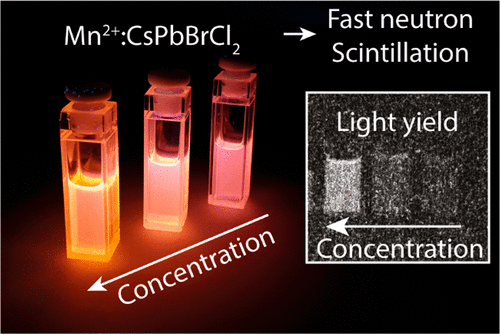当前位置:
X-MOL 学术
›
ACS Energy Lett.
›
论文详情
Our official English website, www.x-mol.net, welcomes your
feedback! (Note: you will need to create a separate account there.)
Highly Concentrated, Zwitterionic Ligand-Capped Mn2+:CsPb(BrxCl1–x)3 Nanocrystals as Bright Scintillators for Fast Neutron Imaging
ACS Energy Letters ( IF 19.3 ) Pub Date : 2021-11-12 , DOI: 10.1021/acsenergylett.1c01923 Federico Montanarella 1, 2 , Kyle M McCall 1, 2 , Kostiantyn Sakhatskyi 1, 2 , Sergii Yakunin 1, 2 , Pavel Trtik 3 , Caterina Bernasconi 1, 2 , Ihor Cherniukh 1, 2 , David Mannes 3 , Maryna I Bodnarchuk 1, 2 , Markus Strobl 3 , Bernhard Walfort 4 , Maksym V Kovalenko 1, 2
ACS Energy Letters ( IF 19.3 ) Pub Date : 2021-11-12 , DOI: 10.1021/acsenergylett.1c01923 Federico Montanarella 1, 2 , Kyle M McCall 1, 2 , Kostiantyn Sakhatskyi 1, 2 , Sergii Yakunin 1, 2 , Pavel Trtik 3 , Caterina Bernasconi 1, 2 , Ihor Cherniukh 1, 2 , David Mannes 3 , Maryna I Bodnarchuk 1, 2 , Markus Strobl 3 , Bernhard Walfort 4 , Maksym V Kovalenko 1, 2
Affiliation

|
Fast neutron imaging is a nondestructive technique for large-scale objects such as nuclear fuel rods. However, present detectors are based on conventional phosphors (typically microcrystalline ZnS:Cu) that have intrinsic drawbacks, including light scattering, γ-ray sensitivity, and afterglow. Fast neutron imaging with colloidal nanocrystals (NCs) was demonstrated to eliminate light scattering. While lead halide perovskite (LHP) FAPbBr3 NCs emitting brightly showed poor spatial resolution due to reabsorption, the Mn2+-doped CsPb(BrCl)3 NCs with oleyl ligands had higher resolution because of large apparent Stokes shift but insufficient concentration for high light yield. In this work, we demonstrate a NC scintillator that features simultaneously high quantum yields, high concentrations, and a large apparent Stokes shift. In particular, we use long-chain zwitterionic ligand capping in the synthesis of Mn2+-doped CsPb(BrCl)3 NCs that allows for attaining very high concentrations (>100 mg/mL) of colloids. The emissive behavior of these ASC18-capped NCs was carefully controlled by compositional tuning that permitted us to select for high quantum yields (>50%) coinciding with Mn-dominated emission for minimal self-absorption. These tailored Mn2+:CsPb(BrCl)3 NCs demonstrated over 8 times brighter light yield than their oleyl-capped variants under fast neutron irradiation, which is competitive with that of near-unity FAPbBr3 NCs, while essentially eliminating self-absorption. Because of their rare combination of concentrations above 100 mg/mL and high quantum yields, along with minimal self-absorption for good spatial resolution, Mn2+:CsPb(BrCl)3 NCs have the potential to displace ZnS:Cu as the leading scintillator for fast neutron imaging.
中文翻译:

高浓度、两性离子配体封端的 Mn2+:CsPb(BrxCl1–x)3 纳米晶体作为快速中子成像的明亮闪烁体
快中子成像是一种用于大型物体(如核燃料棒)的无损技术。然而,目前的探测器基于传统的磷光体(通常是微晶 ZnS:Cu),这些磷光体具有固有的缺陷,包括光散射、γ 射线敏感性和余辉。使用胶体纳米晶体 (NCs) 进行的快速中子成像被证明可以消除光散射。虽然卤化铅钙钛矿 (LHP) FAPbBr 3 NCs 由于重吸收而显示出较差的空间分辨率,但 Mn 2+掺杂的 CsPb(BrCl) 3具有油基配体的 NC 具有更高的分辨率,因为明显的斯托克斯位移大,但浓度不足以获得高光产率。在这项工作中,我们展示了一种 NC 闪烁体,它同时具有高量子产率、高浓度和大的明显斯托克斯位移。特别是,我们在合成 Mn 2+掺杂的 CsPb(BrCl) 3 NC 时使用长链两性离子配体封端,从而获得非常高浓度 (>100 mg/mL) 的胶体。这些 ASC18 封端的 NCs 的发射行为是通过成分调整仔细控制的,这使我们能够选择高量子产率 (>50%) 与 Mn 主导的发射相吻合,以实现最小的自吸收。这些定制的 Mn 2+ :CsPb(BrCl) 3在快速中子照射下,NCs 显示出比其油基封端的变体高 8 倍以上的光输出,这与接近统一的 FAPbBr 3 NCs具有竞争力,同时基本上消除了自吸收。由于 Mn 2+ :CsPb(BrCl) 3 NCs罕见地结合了超过 100 mg/mL 的浓度和高量子产率,以及最小的自吸收以获得良好的空间分辨率,因此有可能取代 ZnS:Cu 作为主要闪烁体用于快速中子成像。
更新日期:2021-12-10
中文翻译:

高浓度、两性离子配体封端的 Mn2+:CsPb(BrxCl1–x)3 纳米晶体作为快速中子成像的明亮闪烁体
快中子成像是一种用于大型物体(如核燃料棒)的无损技术。然而,目前的探测器基于传统的磷光体(通常是微晶 ZnS:Cu),这些磷光体具有固有的缺陷,包括光散射、γ 射线敏感性和余辉。使用胶体纳米晶体 (NCs) 进行的快速中子成像被证明可以消除光散射。虽然卤化铅钙钛矿 (LHP) FAPbBr 3 NCs 由于重吸收而显示出较差的空间分辨率,但 Mn 2+掺杂的 CsPb(BrCl) 3具有油基配体的 NC 具有更高的分辨率,因为明显的斯托克斯位移大,但浓度不足以获得高光产率。在这项工作中,我们展示了一种 NC 闪烁体,它同时具有高量子产率、高浓度和大的明显斯托克斯位移。特别是,我们在合成 Mn 2+掺杂的 CsPb(BrCl) 3 NC 时使用长链两性离子配体封端,从而获得非常高浓度 (>100 mg/mL) 的胶体。这些 ASC18 封端的 NCs 的发射行为是通过成分调整仔细控制的,这使我们能够选择高量子产率 (>50%) 与 Mn 主导的发射相吻合,以实现最小的自吸收。这些定制的 Mn 2+ :CsPb(BrCl) 3在快速中子照射下,NCs 显示出比其油基封端的变体高 8 倍以上的光输出,这与接近统一的 FAPbBr 3 NCs具有竞争力,同时基本上消除了自吸收。由于 Mn 2+ :CsPb(BrCl) 3 NCs罕见地结合了超过 100 mg/mL 的浓度和高量子产率,以及最小的自吸收以获得良好的空间分辨率,因此有可能取代 ZnS:Cu 作为主要闪烁体用于快速中子成像。











































 京公网安备 11010802027423号
京公网安备 11010802027423号